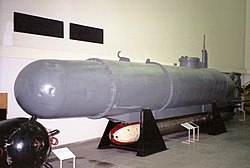Pike (submarine)
|
Representation of the pike
|
||||||||||||
|
||||||||||||
|
||||||||||||
|
||||||||||||
|
||||||||||||
The pike , (project designation type XXVII A) was a miniature submarine mass-produced during the Second World War for the small combat units of the German Navy . Its unsatisfactory sea behavior meant that the pike was not used for frontline operations. Instead, it acted as a teaching and training boat for the future crews of the small submarine Seehund . Nor is it identical to the Steinhuder Pike .
Development history
The pike was created as an official draft of the submarine design office of the OKM against the background of the successful British attack on the Tirpitz at the end of 1943. In this attack, two British X-Craft type submarines got through the network locks of the anchored Tirpitz and placed two ground mines that caused great damage to the battleship. This attack, as well as the loss of the Scharnhorst on December 26, 1943, led to a critical examination of possible uses and chances of success with regard to small-scale maritime weapons by the German navy.
For the development of the Hecht , the OKM drew up a list of requirements with the properties of the small submarine. With a displacement of 7 tons, the boat should have a range of around 90 nautical miles and be able to attach a stick mine to a ship anchored behind a net lock. In addition, it should have the following properties:
- Avoidance of a form suitable for surface travel
- Waiver of diving cells ; the output should only by the flooding of the control cells can be achieved
- small tower structure
- retractable periscope with deflector
- Gyro compass with converter
Based on these specifications, a first prototype was created at the Germania shipyard in Kiel . However, its design soon had to be adapted to the changed requirements of the OKM. This now demanded that, in addition to attacking anchored ships, fighting sea targets in the open sea should also be possible. The boat should also be designed for overwater travel. Instead of the mine head, it should also be possible to mount a torpedo . Alternatively, the mine head should also be equipped with additional batteries to increase the range of the boat. The pike should no longer be brought into its operational area by larger naval units, as initially planned, but should be able to operate independently from any open coast.
The original type of pike thus created was given a two-man crew. The primary armament was a 53.3-cm torpedo of the type G 7e , which was attached centrally under the keel of the boat. The mine in the bow of the boat could be released from the control center. Attempts with special parts that would have made it possible to transport two combat swimmers and their equipment were not carried out.
The prototype was used by the shipbuilding research institute in Hamburg for sea trials and various towing tests. In the overall assessment it was found that the pike had a satisfactory underwater shape, but neither with or without a bow head had good above water sailing characteristics. Modified and lengthened noses and a tower cladding with a more favorable profile did not result in any significant improvements.
Series production
Although the OKM was aware of the weaknesses of the pike , the Germania shipyard was awarded the contract for 50 boats. This was also due to the fact that at that time, with the exception of the newch and the beaver, there were no other ready-to-build constructions of miniature submarines. The pike should only act as a training boat from the start. The first two boats ( U 2111 and U 2112 ) were delivered in May 1944; U 2113 followed in June . Only these three were equipped with a mine head. Seven boats were delivered in July 1944 and another 42 in August 1944. After that the series production was stopped so that the total stock consisted of 53 boats.
Rating
The smallest submarine received its classification during the construction period. The pike was a clumsy, poor and unmaneuverable boat with disastrous sea and diving properties. At no time did it meet its requirements and therefore only served as a training boat. Its further development paved the way for the seal (Type XXVII B).
literature
- Harald Fock: Naval small weapons. Manned torpedoes, small submarines, small speedboats, explosives yesterday - today - tomorrow. Nikol, Hamburg 1996, ISBN 3-930656-34-5 , pp. 63-65.
- Eberhard Rössler : History of the German submarine construction. 2nd Edition. Bernard & Graefe Verlag, Bonn 1996, ISBN 3-86047-153-8 .
- Richard Lakowski: German U-Boats secret 1935–1942. With 200 previously unpublished documents from the files of the Kriegsschiffbau office. 3. Edition. Brandenburgisches Verlagshaus, Berlin 1997, ISBN 3-89488-030-9 .
- Hans H. Hildebrand, Albert Röhr, Hans-Otto Steinmetz: The German warships. Biographies, a mirror of naval history from 1815 to the present. Mundus Verlag, Ratingen 1995, ISBN 3-88385-028-4 .

